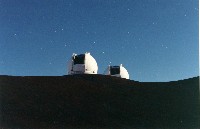Seattle (January 8th, 2007) Astronomers using the W. M. Keck Observatory have discovered a triple quasar.
Quasars are powerful sources of electromagnetic energy, which includes radio waves and light. They are believed to be powered by supermassive black holes in the centers of galaxies.
While roughly 100,000 quasars and dozens of double quasars have been observed in recent years, the discovery by scientists at the California Institute of Technology and Ecole Polytechnique Federale de Lausanne (EPFL) in Switzerland is the first involving quasars from three relatively close galaxies.
It also shows how large telescopes like the twin instruments operated by the Keck Observatory atop Mauna Kea are furthering humankind’s understanding of the universe.
“As more binary and triple quasar systems are discovered, science will have a new tool with which to understand how galaxies and supermassive black holes in the distant universe may have developed and changed over time,” said Dr. Taft Armandroff, director of the W. M. Keck Observatory. “This is an area of research for which large telescopes like Keck I are well-suited.”
S. George Djorgovski, a Caltech professor and the leader of the team which made the discovery, said quasars are thought to be powered by gas falling into the black holes, a process believed to be enhanced when galaxies collide. The triple quasar is located about 10.5 billion light years away – a time when galaxy interactions were at their peak, Djorgovski said.
Such a mingling of galaxies would explain the increasing number of double or binary quasars discovered in recent years as well as the presence of the triple quasar, according to Ashish Mahabal, another Caltech scientist involved in the discovery.
Although quasars are extremely bright, capable of producing more light than an entire galaxy of a hundred billion stars, their massive energy comes from an area smaller than our solar system.
The latest discovery began modestly in 1989 with the finding of a distant quasar named LBQS 1429-008 by astronomers at Cambridge in England. The astronomers, led by Dr. Paul Hewett of Cambridge’s Institute of Astronomy, also found a fainter quasar in the same area.
However, Hewett and his colleagues at first believed the second quasar to be a case of gravitational lensing. That concept, proffered by Albert Einstein in his theory of relativity, involves a large mass such as a cluster of galaxies which can cause a light image to split, in essence creating a double image. But research over the past several years has prompted astronomers to propose that the find was actually a pair of close quasars.
And then a third, even fainter quasar was found using observations from one of Keck’s twin 10-meter telescopes combined with measurements from the European Southern Observatory’s 8.2-meter Very Large Telescope located in Chile.
Extensive computer modeling carried out by Djorgovski’s research team appears to rule out the possibility that the triple quasar could be the product of gravitational lensing. They also were unable to find any galaxy which could be producing such a lensing phenomenon. In addition, the team was able to document small but significant differences in the properties of the three quasars, lending further credence to the belief they are separate entities.
Additional information is posted to Dr. George Djorgovski’s Web site at: http://www.astro.caltech.edu/~george/qqq/
The findings were reported at the January 8th meeting of the American Astronomical Society in Seattle. A paper describing the research also has been submitted to the Astrophysical Journal Letters. Other co-authors include Prof. Georges Meylan, leader of the portion of the team from Ecole Polytechnique Fédérale de Lausanne in Switzerland which included Dr. Domonique Sluse; Dr. Eilat Glikman of Caltech; and Dr. David Thompson, an astronomer at the University of Arizona’s Large Binocular Telescope Observatory.
The W. M. Keck Observatory is operated by the California Association for Research in Astronomy. CARA is a non-profit corporation with a governing board consisting of directors from the California Institute of Technology and the University of California. Input to the board is provided by the National Aeronautics and Space Administration, better known as NASA, and by the Los Angeles-based W.M. Keck Foundation which provided grants of more than $140 million to build the twin Keck telescopes and support facilities. The W.M. Keck Observatory, which has its headquarters in Waimea, has an annual operating budget of $11 million and 125 full-time employees, making it one of Waimea’s biggest employers.


